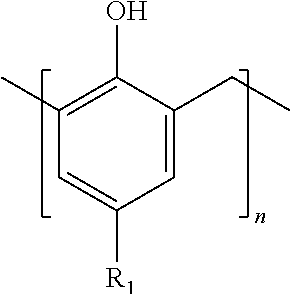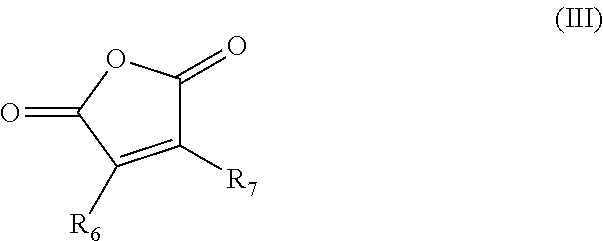Temperature-stable paraffin inhibitor compositions
- Summary
- Abstract
- Description
- Claims
- Application Information
AI Technical Summary
Benefits of technology
Problems solved by technology
Method used
Image
Examples
working examples
[0106]A number of working examples were composed and tested for flow indicative of solidification point depression (e.g., pour point temperatures). The compositions tested herein are said to “pour or flow” at the indicated temperature when the PIC of each working example, vertically at rest on a substantially horizontal surface the cylindrical container (radius 1 inch, height 2 inches), flows observably within about 10 seconds when tipped to a substantially horizontal position. This amount of flow is known to be sufficient to indicate that the composition is pourable or pumpable for use in the field, where such concentrates are applied to one or more crude oil transportation or storage systems. The flowing samples are said to have a pour point at temperatures where the flow is observed. The pour point is above the solidification temperature for a given sample. The effect on pour point was observed according to ASTM D-97 test method (including storage for a half hour in a freezer set...
working examples 1-7
[0107]Working examples 1-7 are a combination of hydroxyl containing low Log P molecules (e.g., various alcohols) with an alkyl phenol formaldehyde resin PI polymer (50% active, that is, 50% of the alkyl phenol formaldehyde resin composition is the alkyl phenol formaldehyde resin, with the balance including xylene, toluene, and ethyl benzene), FloZol 2252, available from Lubrizol Corp. of Wickliffe Ohio. The balance of each working example 1-7, includes HAN (although additional experimentation showed similar results with xylene and toluene). About 2 wt % or about 5 wt % hydroxyl containing low Log P molecules were mixed with the PI polymer and HAN in of the each working example 1-7. The effect on pour point was observed according to ASTM D-97 test method (storage for at least one half hour in a freezer set at a specific temperature (e.g., −60° C.)). The specific low Log P molecules, amounts thereof, amounts of PI polymer, with the balance comprising a refined petroleum distillate or ...
working examples 8-10
[0109]The effect of low Log P molecules was tested on PICs comprising OMAC PI polymers, specifically OMAC amide polymer systems. Working example 8 was a control sample having no low Log P molecule therein, and working examples 9 and 10 contained 2 ethyl hexanol and methanol respectively. The balance of working examples 8-10 included surfactants and HAN. The surfactants included
TABLE 3Alpha-Olefin / MaleicAnhydrideSurfac-Low LogPLow LogPWorkingCopolymertantsMoleculeMoleculesPourExample(wt %)(wt %)Type(wt %)Point8129.3—0 +20° C.9129.32-Ethyl5Hexanol10129.3Methanol5
[0110]As shown in Table 3, the pour point of working examples 9 and 10 were depressed from the pour point of 20° C. for working example 8. The pour point of working example 9, having 5 wt % 2-ethyl hexanol therein, was depressed by about 10° C. The pour point of working example 10, having 5 wt % methanol therein, was depressed by about 41° C.
PUM
 Login to View More
Login to View More Abstract
Description
Claims
Application Information
 Login to View More
Login to View More - R&D
- Intellectual Property
- Life Sciences
- Materials
- Tech Scout
- Unparalleled Data Quality
- Higher Quality Content
- 60% Fewer Hallucinations
Browse by: Latest US Patents, China's latest patents, Technical Efficacy Thesaurus, Application Domain, Technology Topic, Popular Technical Reports.
© 2025 PatSnap. All rights reserved.Legal|Privacy policy|Modern Slavery Act Transparency Statement|Sitemap|About US| Contact US: help@patsnap.com



